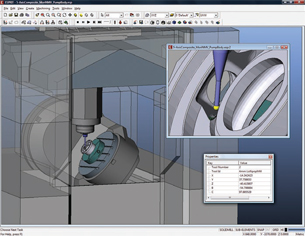ESPRIT 2009 Introduces a Fresh Approach to Complex 5-axis Milling, 2 in a Series
As multiaxis machine tools become more complex, DP Technology has developed an elegant way to program them.
February 2, 2009
By Ann Mazakas
« Page 1 |2
In this way, the user can create his or her own customized toolpath as a combination of available choices. In other words, by choosing from the five available machining patterns and the four different tool orientation strategies, the user has 20 different ways to machine the part. Add to that the ability to lock an axis and a five-axis tool path is quickly converted to a four-axis application.
The interface is simplified by only displaying options that apply to the current work situation. For example, if a parametric machining pattern is chosen, the user is prompted to select the drive surface and the parametric flow directions the tool should follow. If the user decides to change to a simple boundary offset pattern the interface updates to display fewer options.
As the user chooses machining options, the interface updates to guide the user in a logical manner through the programming process. This step-by-step guidance helps the user avoid errors in the toolpath definition without imposing limitations. If the user decides to change a previous option, the system responds by displaying a new set of choices.
 The new 5-Axis Composite Milling function from DP Technology takes full advantage ofsimultaneous machine movement in a streamlined format that combines power with ease-of-use. |
3D Features
In addition to the compact and simplified Composite cycle, ESPRIT 2009 has also simplified the way users select areas to be machined. A new type of freeform feature lets the user select and save the surfaces to be machined and the surfaces to be avoided as a single object. Knowing that different types of surfaces require different machining strategies, any number of these freeform features can be created on a single part model. The user can then select a single feature to machine an entire pre-defined area.
The design concept of consistency and ease-of-use is extended so that the same interface is used for the freeform features, the Composite cycle, the tool manager, and the operation manager in a tabbed layout. The user stays in a familiar environment without the need to open and exit multiple dialog boxes.
Adaptable for the Future
From the viewpoint of the software developer, the Composite function requires an in-depth analysis of each step used in the process of generating multiaxis toolpaths. It also requires real-world experience working with the types of multiaxis machines that are used every day on the shop floor plus the new technology being developed by machine tool builders.
This in-depth analysis has led to the Composite cycle being composed of a collection of separate components that perform well separately and together. These components are analyzed and tested to guarantee the complete interchangeability of any component at any step. This analysis effort lends itself to a high rate of reliability in the resulting software, which ultimately benefits the user. Efficiency is also achieved because each component is created only once, eliminating the redundancy that occurs when advanced functionality is broken into a slew of machining functions.
The advantage to this type of functionality is that new machining patterns and tool orientation strategies can be added to the software at any time in the future as the technology for multiaxis machines advances. The new 5-Axis Composite Milling function from DP Technology marks a departure from traditional CAM software development so that ESPRIT can easily keep pace with the rapidly evolving technology on the shop floor.
More Info:
DP Technology
Camarillo,CA
Ann Mazakas is manager of technical communications at DP Technology, in Camarillo, CA. Her background includes many years in the manufacturing industry, particularly in the design and manufacture of products and molds. She has been a writer specializing in metalworking and CAD/CAM systems since 1998. To comment on this article, send an e-mail to [email protected].
« Page 1 |2
Subscribe to our FREE magazine, FREE email newsletters or both!
About the Author
DE’s editors contribute news and new product announcements to Digital Engineering.
Press releases may be sent to them via [email protected].






